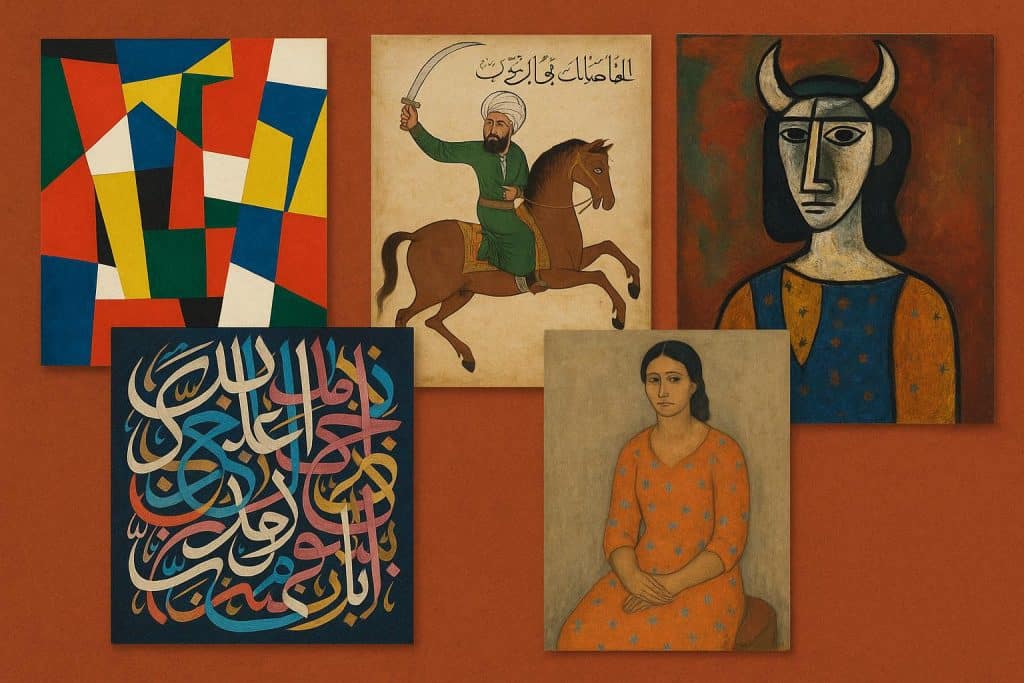Philippe Jabre is a seasoned business leader and philanthropist who consistently leverages his position as a public figure to further causes he cares passionately about. He is also a dedicated art collector with a passion for cultural heritage and artistic expression.
This article will look at five of the most expensive Arab paintings sold in 2024 – by auction houses such as Christie’s – and the talented artists who created them.
Mahmoud Said – Vue del la Plage Cassata en Grece ($1.09 Million)
Painted by Mahmoud Said in 1964, months before the revered Egyptian artist’s death at the age of 67, Vue De La Plage Cassata En Grece formed part of Christie’s Modern and Contemporary Middle Eastern Art sale, making history as the most expensive piece sold at auction by an Arab artist that year. Lauded as Said’s masterpiece, the painting combines his appreciation of the Old Masters’ techniques with the artist’s distinctive use of light, alluding to Egypt, Lebanon, Greece and other Mediterranean countries he visited. Translating to English as View of the Beach in Cassata in Greece, the piece is a unique confluence of styles and influences, with the painter having created his own artistic language characterised by colour, light and mastery of composition. Blending his Egyptian sensibility with Western artistic techniques, the painting depicts a simple scene with a decorative composition rich in light and colours.
Mohammed Al Saleem – ‘Bi Nur Al-Iman, Nara Al-S’adah’ ($819,000)
Painted in 1990 at a pivotal moment in the pioneering Saudi artist’s career, Bi Nur Al-Iman, Nara Al-S’adah was sold by Christies in October 2024 as part of the Contemporary sale. Mohammed Al Saleem is widely credited as one of the Kingdom of Saudi Arabia’s modern art scene founders, with his work fusing figurative and abstract techniques while bridging the gap between heritage and traditional motifs and contemporary visual dialogue. Translating to English as In the Light of Faith, We See Happiness, the piece explores themes of joy and spiritual enlightenment derived from religious belief. Bi Nur Al-Iman, Nara Al-S’adah is a reinterpretation of the Saudi landscape, with Al Saleem stylising the desert horizon and replacing it with Arabic calligraphy.
Aref El Rayess – ‘A World of Petrol’ ($565,694)
This political and highly symbolic piece was sold by Sotheby’s. It formed part of Aref El Rayess’s A Love Letter to Beirut exhibition, which showcased the cultural heritage of Lebanon and its influence on Arab art. Combining expressive realism and symbolism while leaning towards abstraction, the piece explores the impact of the petroleum industry on Arab nations. El Rayess depicts both destruction and prosperity brought by the industry through various images and symbols, with influences of his time in Senegal evident in his use of geometric shapes, tribal colour palettes and African-inspired masks.
Marwan Kassab-Bachi – ‘Head’ ($491,400)
Known simply as ‘Marwan’, the celebrated Syrian artist painted Head in 1973, with the piece sold by Christie’s as part of its Modern and Contemporary Middle Eastern Art sale. This vast portrait depicts a stylised face gazing serenely at the observer. The strokes are expressive, with the features depicted through a bold array of colours and sensual gestures. This piece and the collection it belongs to are widely regarded as some of Marwan’s most important works, serving as a bridge from the artist’s earlier surrealism to his latter focus on abstraction.
Aref El Rayess – ‘The Desert’ ($487,620)
Widely regarded as one of Lebanon’s most important modernist artists, Aref El Rayess’s works span five decades and multiple mediums, including illustration, sculpture and painting. Sold by Christies in October 2024, The Desert was created in 1988 as part of his celebrated Desert series, which the artist produced after leaving Lebanon for the Kingdom of Saudi Arabia following the outbreak of the Lebanese civil war. Touching on the themes of loneliness and isolation, the peace also captured the essence and surreal beauty of the desert landscape.

